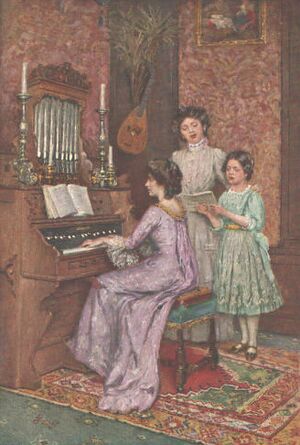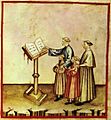Church music facts for kids
Church music is special music made for Christian worship. You hear it in churches, chapels, and cathedrals, or wherever Christians gather to pray and sing. It's a type of religious music, but not all religious music is church music. For example, a song might be about faith, but if it's meant for a concert hall and not a church service, it's usually not called church music. Think of Verdi's Requiem; it uses church words but was written for concerts.
Church music has changed a lot over time. Different Christian groups have had different ideas about how music should be part of worship. Most church music involves singing. Choirs often sing words from the liturgy, which are the official words used in services. The pipe organ is a very important instrument in church music, though other instruments have been used too.
For many years, composers writing for the church often used older music styles. For example, in the early 17th century, composers like Claudio Monteverdi wrote in two styles. They used an "old style" (called "stilo antico") for church music and a "new style" (called "stilo moderno") for non-religious music.
Contents
Music in Early Christian Churches
In the early days of Christianity, churches were found across the Roman Empire. They used different musical traditions that were already there, so music varied a lot. Back then, musical instruments were often linked to devils or dancing. Because of this, they were seen as bad and were not allowed in churches. Only singing was permitted.
In the 4th century, Bishop Ambrosius of Milan introduced antiphons. These are short chants sung before or after a Psalm. He also encouraged new hymns. Psalms were a big part of early Christian worship. Sometimes, one person would sing a psalm, and the congregation would respond with a simple phrase like "Alleluia." This was called "responsorial psalmody." Later, "antiphonal psalmody" developed. This is when two parts of the choir sing verses of a psalm, taking turns. You can still hear this in Anglican cathedrals today.
Gregorian Chant and Catholic Music
The main music in the Catholic Church was called chant or plainchant. It's often known as "Gregorian chant" after St Gregory the Great, who was Pope from 590 to 604. The words sung were the standard ones from the liturgy. Many composers set the words of the Mass to music. Music for the dead was called a Requiem Mass. There was also music for evening prayers like Vespers and Compline.
Until the 16th century, the organ was mostly used to accompany (play along with) the singing. During the Renaissance period, great composers like Giovanni da Palestrina and Orlande de Lassus wrote polyphonic music for the Catholic Church. Polyphonic means music with many independent melodic lines played or sung at the same time. They often wrote motets, which are short pieces based on religious texts not always part of the main service.
During the Reformation, some Protestant groups separated from the Catholic Church. From then on, Catholic and Protestant music started to develop in different ways.
Protestant Church Music
Martin Luther began the Protestant movement in Germany. In the Lutheran church, the chorale became very important. Chorales are like hymns, and Luther himself wrote many tunes for them. The famous composer Johann Sebastian Bach based much of his organ music on chorales. These pieces are called Chorale Preludes.
Choirs in Protestant churches often sang motets. Sometimes these choir pieces grew very long and became cantatas. The words for cantatas were often written by poets or taken from the Bible, not always from the official liturgy. Bach wrote about 200 cantatas for the church. He also wrote two major passions, which tell the story of Jesus dying on the cross. Other important composers who wrote Protestant church music include Heinrich Schütz, Dietrich Buxtehude, and Felix Mendelssohn-Bartholdy.
Catholic Church Music
Music for the Catholic Church also includes instrumental pieces like "church cantatas." Composers like Arcangelo Corelli and Wolfgang Amadeus Mozart wrote many of these. Mozart also composed several masses. Important Italian composers from the 16th and 17th centuries who wrote church music include Giovanni Gabrieli and Claudio Monteverdi. In the 19th century, composers like Rheinberger and Max Reger wrote church music in the Romantic style. French composers of this time wrote in a style that was similar to non-religious music.
Church Music in England
When King Henry VIII separated from the Catholic Church, he started his own church, known as the Anglican church. Many great composers wrote music for Anglican services. Their choir music often included "service settings" (music for parts of the service) and anthems. They also wrote many hymn tunes.
Key composers include William Byrd (who also wrote Catholic music) and Thomas Tallis from the Renaissance period. In the Baroque period, Orlando Gibbons and Henry Purcell were important. Later composers include Samuel Sebastian Wesley, Charles Stanford, Ralph Vaughan Williams, and John Rutter.
Church Music in the United States
Church music in American churches first developed similarly to European music. The Book of Common Prayer was important for American worship. Both Puritans and Baptists believed that congregational singing (everyone singing together) was important.
In the 18th century, "Singing Masters" from Singing Schools in the northeastern states traveled around. They taught people in churches how to sing better. William Billings was a very famous singing master. Because many people couldn't read music, a system called "Lined-out Hymnody" developed. In this, the priest would sing a line, and the congregation would copy him. Later, during the "First Great Awakening," hymns by English composers like Isaac Watts and Charles Wesley became very popular.
In the 19th century, people from different churches met at "Camp Meetings" led by Evangelists. The songs reflected the idea that sinners could be saved by repenting. Music from black people and folk music became important influences. Songs became more tuneful and often had repeating refrains. Sunday Schools for children also became very popular, and many songs were written for them. Gospel songs and negro spirituals also became widely used and shaped American church music.
Church Music in the Orthodox Church
Church music in the Orthodox Church, found in East European countries, is always sung. It is based on the Byzantine musical tradition.
Images for kids
-
Church singing, Tacuinum Sanitatis Casanatensis (14th century)
-
The Introit Gaudeamus omnes, scripted in square notation in the 14th–15th century Graduale Aboense, honours Henry, patron saint of Finland
-
An early printing of Martin Luther's hymn "Ein feste Burg ist unser Gott"






